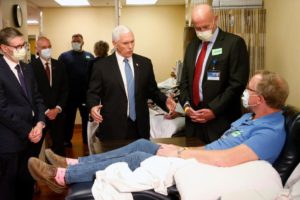One might expect that in a pandemic, a public consensus would arise on how people should protect themselves and others from catching the disease. However, in the US, the spread of COVID-19 has led to very different behaviors, that are divided along political lines. That is translating currently into different camps regarding the need to wear face masks in public. Rather than considering the practical health benefits, some refuse to wear a mask as a signal of solidarity with President Trump and his call for the country to open back up. This has turned into a face mask becoming a partisan symbol, as described in US News:
While not yet as loaded as a “Make America Great Again” hat, the mask is increasingly a visual shorthand for the debate pitting those willing to follow health officials’ guidance and cover their faces against those who feel it violates their freedom or buys into a threat they think is overblown.
That resistance to masks has been stoked by President Trump. Rather than wearing a mask to model desired behavior among the public, he didn’t wear a mask during an appearance at a facility making them. Vice President did the same when visiting the Mayo Clinic.
Wearing a mask, on the other hand, can be seen as an endorsement of the advice of medical personnel and public health officials, namely that wearing a mask protects oneself as well as those around us. In that way it is also signaling social solidarity. Not wearing a mask might be seen as a sign of selfishness – or, from others’ perspective, as an assertion of individual freedom.
In the US, this is a radical change from popular opinion on mask-wearing before the pandemic. While wearing a face mask has long been common practice in many East Asian countries, that has not been the case in the US. Indeed, wearing a mask was often seen negatively; as reported in National Geographic, “masks signaled ‘disease,’ as if the wearer had something to hide”. Not being able to see someone’s face automatically made them suspicious. We are used to reading faces as a way to evaluate others’ actions, attitudes or intentions, so not being able to see facial expressions can be disturbing in a culture not used to seeing face masks. The article points out that people may use other non-verbal cues to make up for the absence of facial expressions, such as excessive, energetic waving or extra-explicit friendly language. It may be that as more US Americans don masks, behaviors will adjust. For now, however, there remains a strongly political symbolism to face masks.

